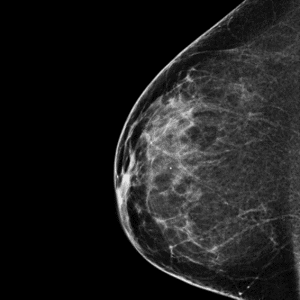
What Is A Mammogram or Digital Mammography?
A mammogram, also known as a digital mammography, is a low dose x-ray which captures a picture of the breast tissue. The breast is carefully positioned on a film cassette and gently compressed with a special paddle so that the maximum amount of tissue will appear in the image. This flattening also helps spread the tissue in dense parts of the breast more evenly so that a clearer picture of these areas can be obtained. It also helps doctors determine which changes are noncancerous (benignNot harmful; not cancerous (referring to a cell or mass).) and which are cancerous (malignantCancerous.). Unlike the standard mammography, the digital mammography captures the images electronically and allows them to be viewed on a computer screen. Although the test is administered the same, the digital mammography enhances visibility by up to 300% making it more likely to see lumps and other abnormal changes that may be present in the breast tissue.
When To Get A Mammogram
Women should begin their first mammogram at age 35 (first mammogram is a baseline x-ray). If the results of this screening are normal, then begin yearly mammogramsA low dose x-ray picture of the breast that allows a doctor to view glandular tissue and determine the presence of cancer. at age 40. For all women regardless of age, The Maurer Foundation recommends a monthly breast self-examination and a yearly clinical breast exam with a doctor.
There has been much confusion about whether the importance of cancer screenings have been overstated. The United States Preventive Services Task Force (USPSTF) has even recommended that women ages 40-49 no longer needed to undergo routine mammograms. We couldn’t disagree more! It is our firm position and that of our founder breast surgeon Dr. Virginia Maurer that screenings can only give you knowledge and knowledge saves lives.
Many women ages 40-49 have had their breast cancer caught in it’s early stages as a result of a routine mammogram. Had these same women waited until age 50, their survival rate would certainly be lower as a result of their more advanced stage of breast cancer. According to a 2010 Swedish study, breast cancer mortality was reduced 29% for women ages 40-49 who received mammograms. Sandra Palmaro, CEO, Canadian Breast Cancer Foundation – Ontario Region explains, “Since 1-in-6 women who die from breast cancer are diagnosed in their 40s, we simply cannot afford to see missed opportunities for earlier detection.”
Until there is a cure for breast cancer, early detection must play a vital role in safe-guarding lives; mammograms are a significant part of a breast cancer early detection strategy.
Screening Vs. Diagnostic Mammograms
Screening mammograms are the routine basic mammograms that most women receive annually. Diagnostic mammograms take longer, are usually performed to receive a proper diagnosis and involve more pictures from different angles and even the magnification of suspicious areas.
Before Your Mammogram
Discuss your plan to get a mammogram with your doctor if you are pregnant, have breast implantsA saline or silicone filled sac used during plastic surgery to enlarge or restore the shape of the breast., or you are positive for the breast cancer geneA sequence in the DNA which can be passed down from parent to child. Genes helps determine physical and functional traits for the body. BRCA1 or BRCA2; special mammography recommendations may apply in these situations. Review our mammogram tips to prepare for the day. There’s also some great mammogram videos that explain the process and will help you visualize the process and the mammography machine a little better.
Mammogram Pictures & Images
These are some example mammograms. The one on the left is normal. The one on the right shows an abnormality that would require further investigation.


Other Types of Breast Imaging
Mammograms are only one type of breast imaging. Other types include breast MRIs and breast ultrasounds. These two types of breast imaging are usually only performed if a routine mammogram is inconclusive or if the patient has a high risk for breast cancer, due to lifestyle, genetics, or other breast cancer risk factors.